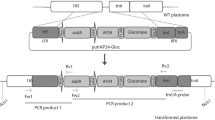Summary
Protoplast-derived calluses of tobacco (Nicotiana tabacum cv. ‘Samsun’) were selected for their resistance to toxins from Pseudomonas syringae pv. tabaci, which causes wildfire disease, and from Alternaria alternata pathotype tobacco, which causes brown spot. A number of plants were regenerated from each of the toxin-selected protoplast-derived calluses. A large percentage of the plants obtained from the second selection cycle calluses were resistant to infection by these pathogens. Resistance to wildfire disease, however, seems to be unrelated to resistance to brown spot disease. Variations in the morphological characteristics of the regenerated plants were found. Results of an assay of the R1 generation indicate that the resistance shown by R0 plants against both disease is heritable.
Similar content being viewed by others
References
Behnke M (1979) Selection of potato callus for resistance to culture filtrates of Phytophthora infestans and regeneration of plants. Theor Appl Genet 55:69–71
Behnke M (1980a) General resistance to late blight of Solanum tuberosum plants regenerated from callus resistant to culture filtrates of Phytophthora infestans. Theor Appl Genet56:151–152
Behnke M (1980b) Selection of dihaploid potato callus for resistance to the culture filtrate of Fusarium oxysporum. Z Pflanzenzücht85254–258
Braun AC (1955) A study on the mode of action of the wildfire toxin. Phytopathology45:659–664
Brettel RIS, Ingram DS (1979) Tissue culture in the production of novel disease resistant crop plants. Biol Rev 54:329–345
Butenko RG, Kuchko AA (1979) Physiological aspects of procurement, cultivation and hybridization of isolated potato protoplasts. Fiziol Rast 26:1110–1119
Carlson PS (1973) Methionine-sulfoximine-resistant mutants of tobacco. Science 180:1366–1368
Chaleff RS, Parsons MF (1978) Direct selection in vitro for herbicide resistant mutants of Nicotiana tabacum. Proc Natl Acad Sci USA75:5104–5107
Gengenbach BG, Green CE (1975) Selection of T-cytoplasm maize callus cultures resistant to Helminthosporum maydis race T pathotoxin. Crop Sci15:645–649
Gengenbach BG, Green CE, Donovan CM (1977) Inheritance of selected pathotoxin-resistance in maize plants regenerated from cell cultures. Proc Natl Acad Sci USA 74:5113–5117
Harrigan WF, McCarce EM (1966) Laboratory methods in microbiology. Academic Press, London New York San Francisco
Heinz DJ (1973) Sugarcane improvement through induced mutations using vegetative propagules and cell culture techniques. In: Induced mutations in vegetatively propagated plants. Int Atomic Energy Agency, Vienna, pp 53–59
Heinz DJ, KrisshnamurthiM, Nickell LG, Maretzki A (1977) Cell, tissue and organ culture in sugarcane improvement. In: Reinert J, Bajaj YPS(eds) Applied and fundamental aspects of plant cell, tissue and organ culture. Springer, Berlin Heidelberg New York, pp 3–17
Kao KN, Miller RA, Gamborg OL, Harvey BL (1970) Variations in chromosome number and structure in plant cells grown in suspension cultures. Can J Genet Cytol 12:297–301
Kartha KK, Michayluk MR, Kao KN, GamborgOL, Constabel F (1974) Callus formation and plant regeneration from mesophyll protoplasts of rape plants (Brassica napus L. cv. ‘Zephyr’). Plant Sci Lett 3:265–271
Linsmaier ME, Skoog F (1974) Organic growth factor requirement of tobacco tissue cultures. Physiol Plant 18:100–127
Maliga P, Breznovits S, MartonL, JobF (1975) Nonmendelian streptomycin-resistant tobacco mutant with altered chloroplasts and mitochondria. Nature (London)255:401–402
Maliga P (1978) Resistant mutants and their use in genetic manipulation. In: Thorpe TA (eds) Frontiers of plant tissue culture. Int Assoc Plant Tissue Culture, Calgary, pp 381–392
Marton L, Maliga P (1975) Control of resistance in tobacco cells to 5-bromodeoxyuridine by a simple mendelian factor. Plant Sci Lett 5:77–81
Mattern U, Strobel G, Shepard J (1978) Reaction to phytotoxins in a potato population derived from mesophyll protoplasts. Proc Natl Acad Sci USA 75:4935–4939
Nagata T, Takebe I (1971) Planting of isolated tobacco mesophyll protoplasts on agar medium. Planta 99:12–22
Nickell LG, Heinz DJ (1973) Potential of cell and tissue culture techniques as aids in economic plant improvement. In: Seb AB (ed) Gene, enzymes and populations. Plenum, New York, pp 109–128
Palacco JC, Palacco ML (1977) Inducing and selecting a valuable mutation in plant cell culture: a tabacco mutant resistant to carboxin. Ann NY Acad Sci 287:385–400
Sacristan MD (1982) Resistance responses to Phoma lingam of plants regenerated from selected cell and embryogenic cultures of haploid Brassica napus. Theor Appl Genet 61:193–200
Shepard JF, Bidney D, Shahin E (1980) Potato protoplasts in crop improvement. Science 208:17–24
Siegemund F (1981) Selektion von Resistenzmutanten in pflanzlichen Zellkulturen, eine Übersicht. Biol Zentralbl 100:155–165
Simons MD (1979) Modification of host-parasite interactions through artificial mutagenesis. Ann Rev Phytopathol 17:75–96
Skirvin RM (1978) Natural and induced variation in tissue culture. Euphytica 27:241–266
Takabe I, Labib G, Melchers G (1971) Regeneration of whole plants from isolated mesophyll protoplasts of tobacco. Naturwissenschaften 58:318–320
Thomas E, King PJ, Potrykus I (1979) Improvement of crop plants via single cells in vitro an assessment. Z Pflanzenzücht 82:1–30
Umiel N (1979) Streptomycin-resistance in tobacco. 3. A test on germinating seedlings indicates cytoplasmic inheritance in the St-R701 mutant. Z Pflanzenphysiol 92:295–301
Vasil IK (1976) The progress, problems, and prospects of plant protoplast research. Adv Agron 28:119–160
Vasil IK, Vasil V, White DWR, Berg HR (1979) Somatic hybridization and genetic manipulation in plants. In: Scott TK (ed) Plant regulation and world agriculture. Plenum, New York, pp 63–84
Wenzel G, Schieder O, Prezewzny T, Sopony SK, Melchers G (1979) Comparison of single cell culture derived Solanum tuberosum L. plants and a model for their application in breeding programs. Theor Appl Genet 55:49–55
Widholm JM (1977) Selection and characterization of amino acid analog resistant plant cell cultures. Crop Sci 17:597–600
Wooley DW, Pringle RB, Braun AC (1952) Isolation of the phytopathogenic toxin of Pseudomonas tabaci, an antagonist of methionine. J Biol Chem 197:409–417
Xu ZH, Davey MR, Cocking EC (1982) Plant regeneration from root protoplasts of Brassica. Plant Sci Lett 24:117–121
Author information
Authors and Affiliations
Additional information
Communicated by K. Tsunewaki
Rights and permissions
About this article
Cite this article
Thanutong, P., Furusawa, I. & Yamamoto, M. Resistant tobacco plants from protoplast-derived calluses selected for their resistance to Pseudomonas and Alternaria toxins. Theoret. Appl. Genetics 66, 209–215 (1983). https://doi.org/10.1007/BF00251145
Received:
Issue Date:
DOI: https://doi.org/10.1007/BF00251145




